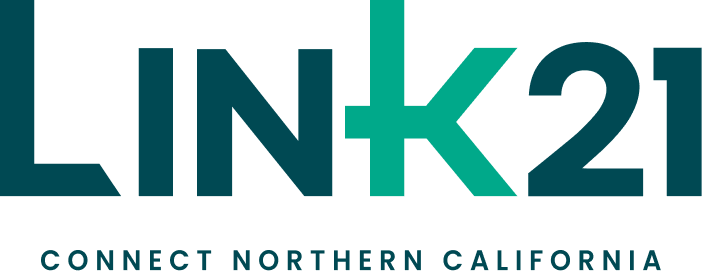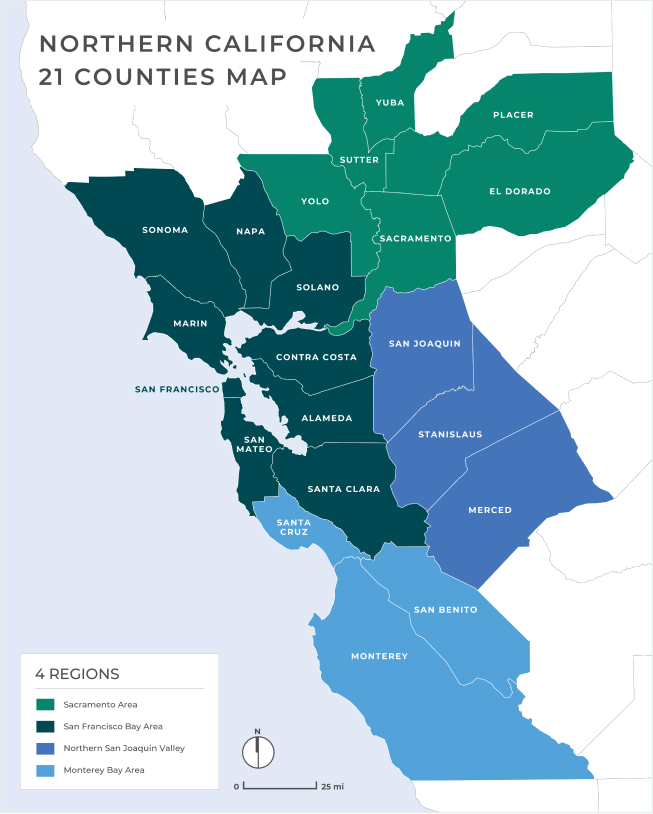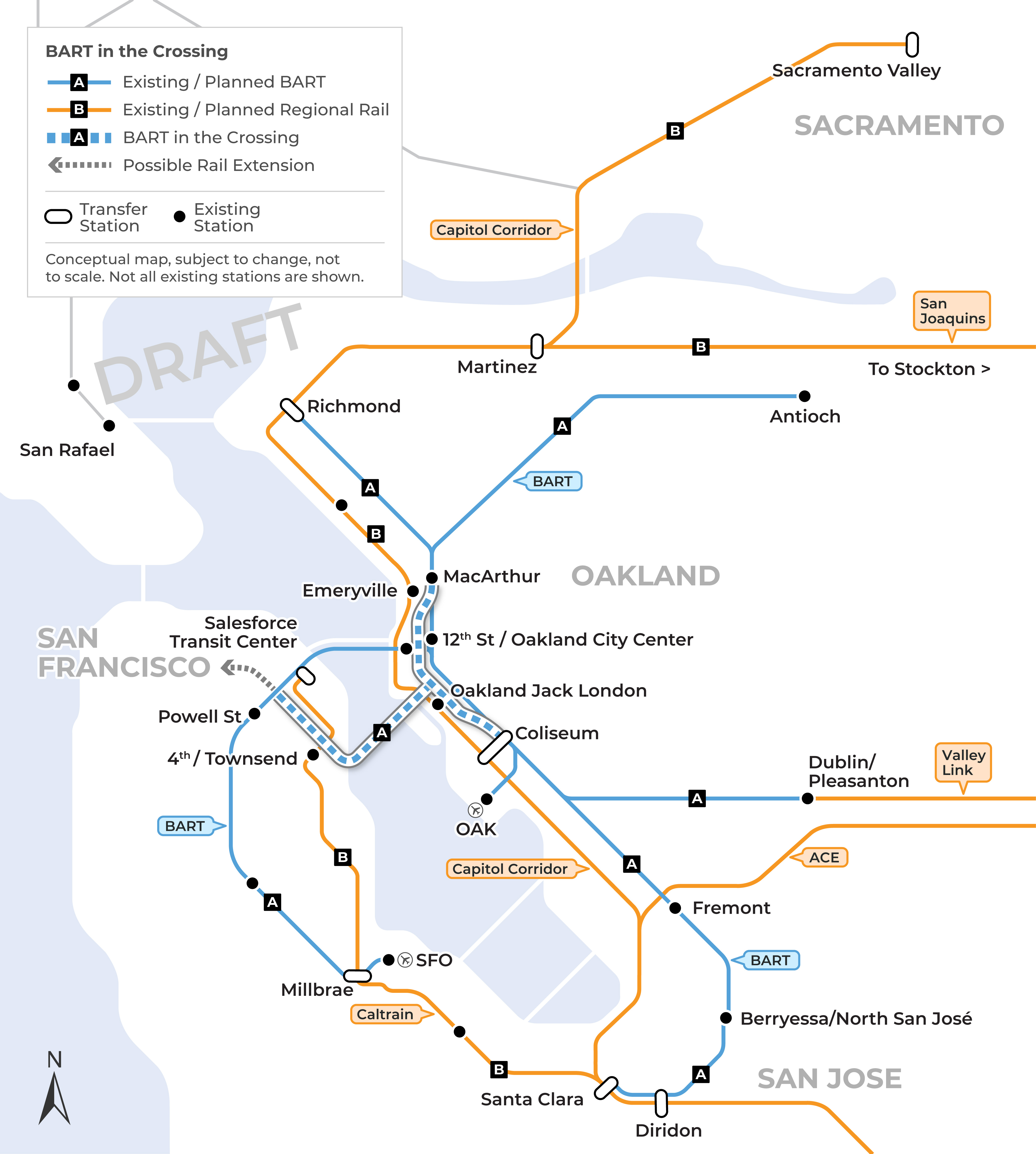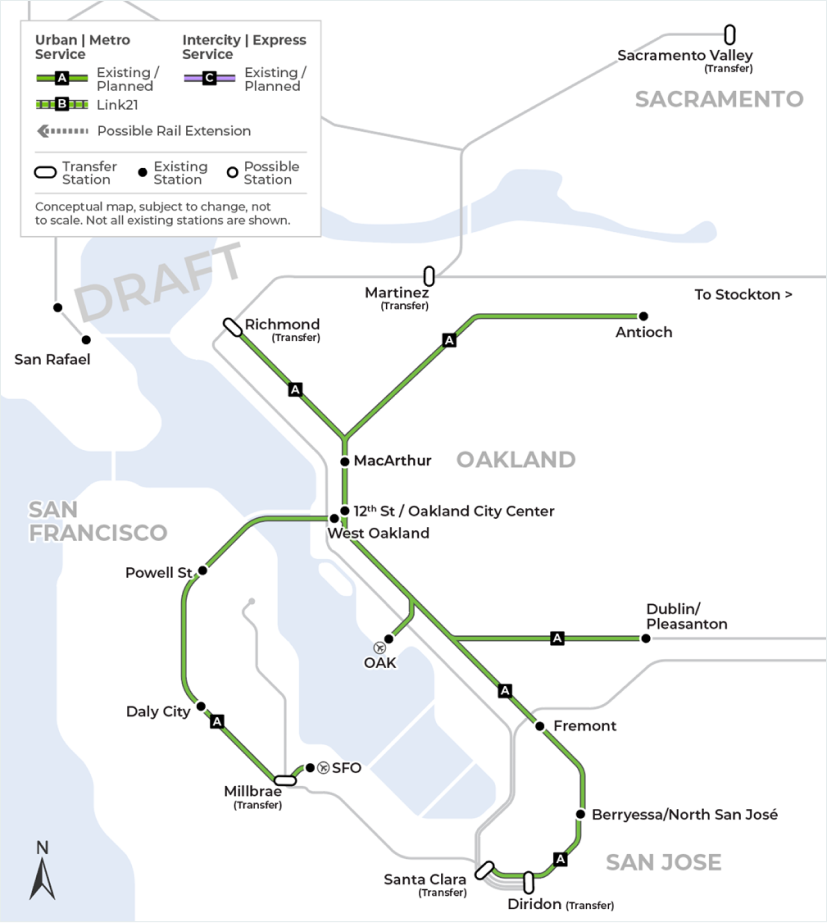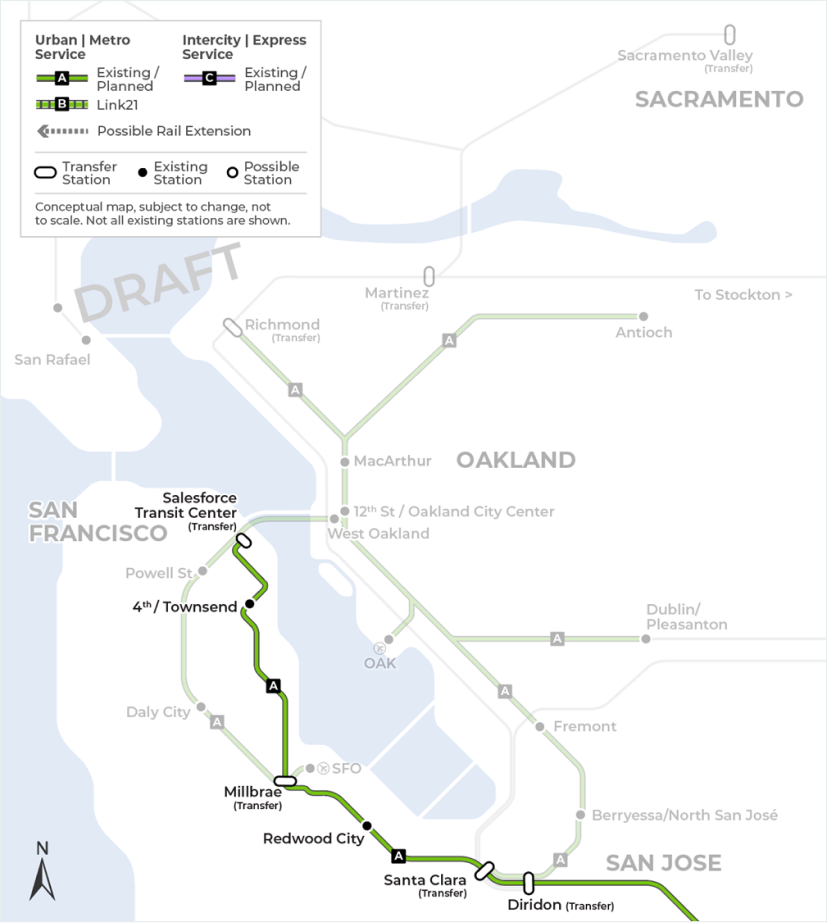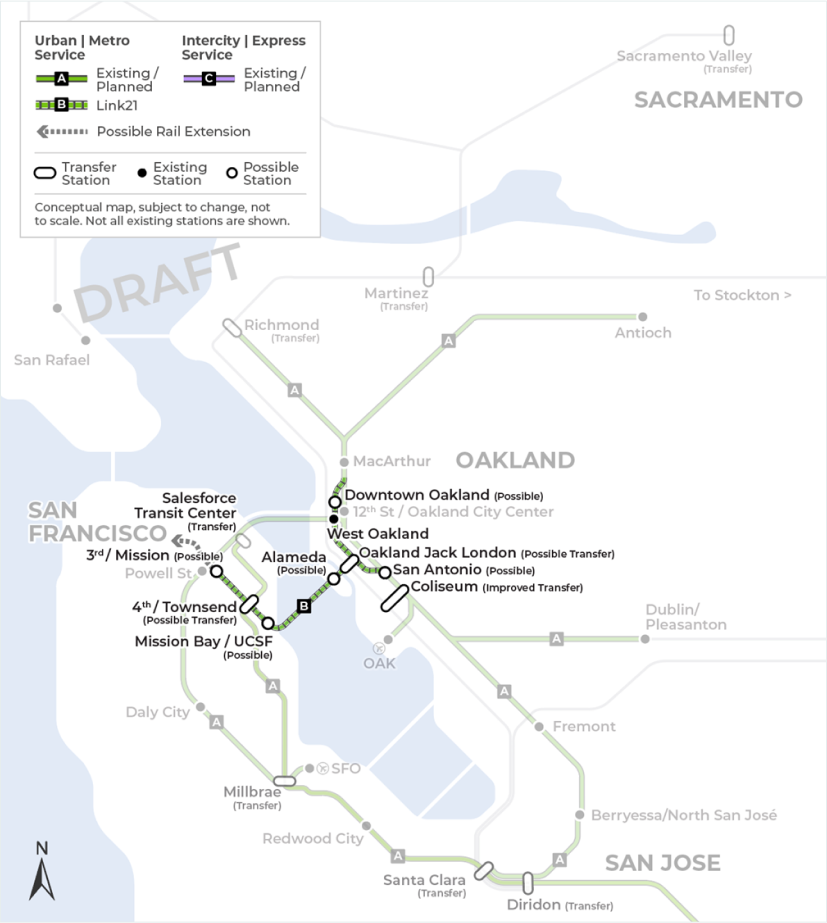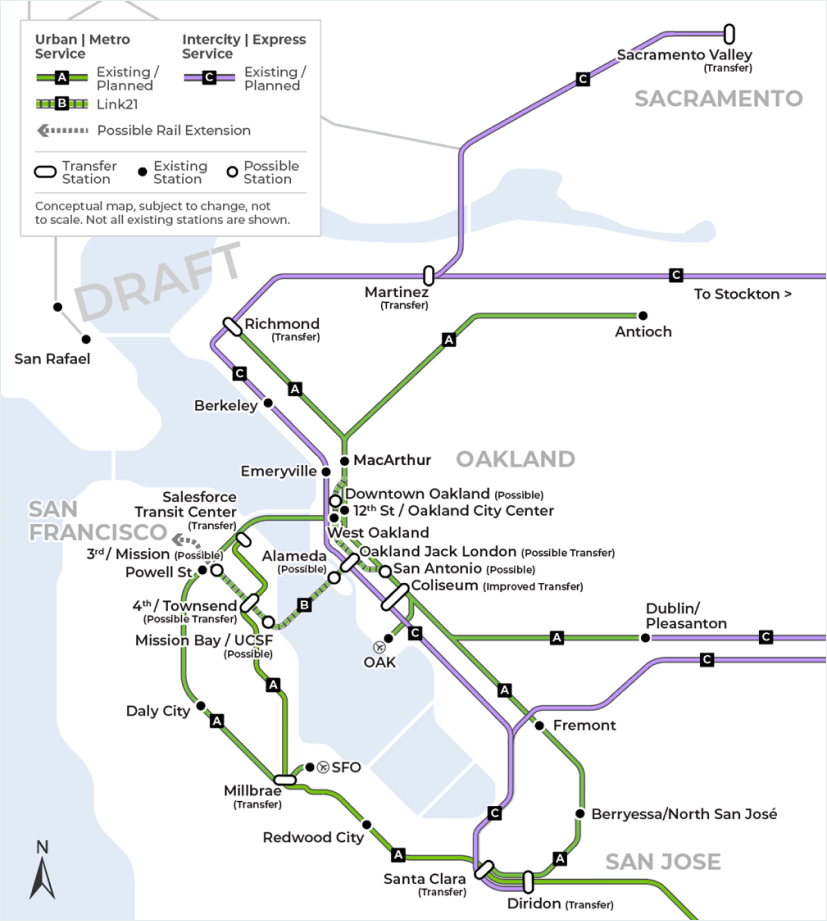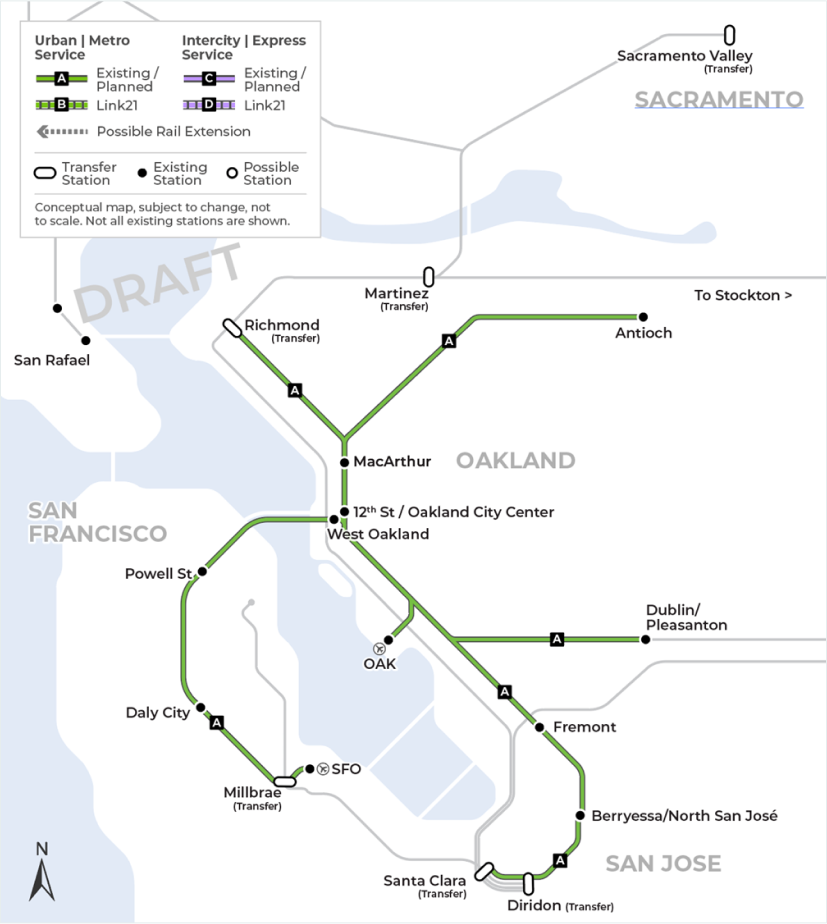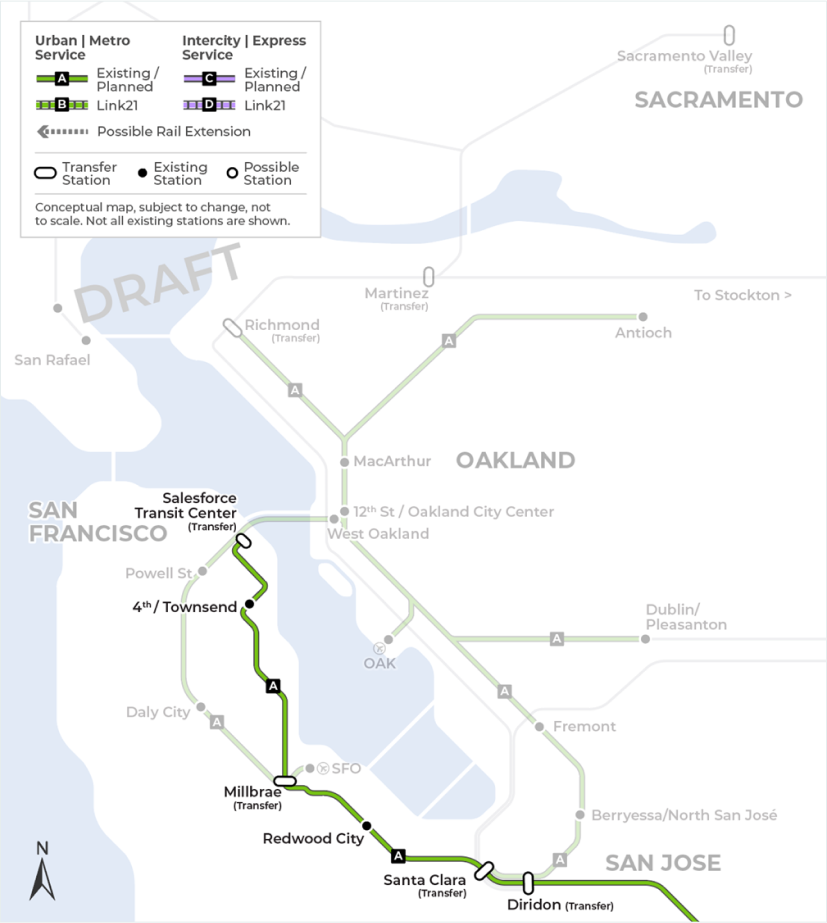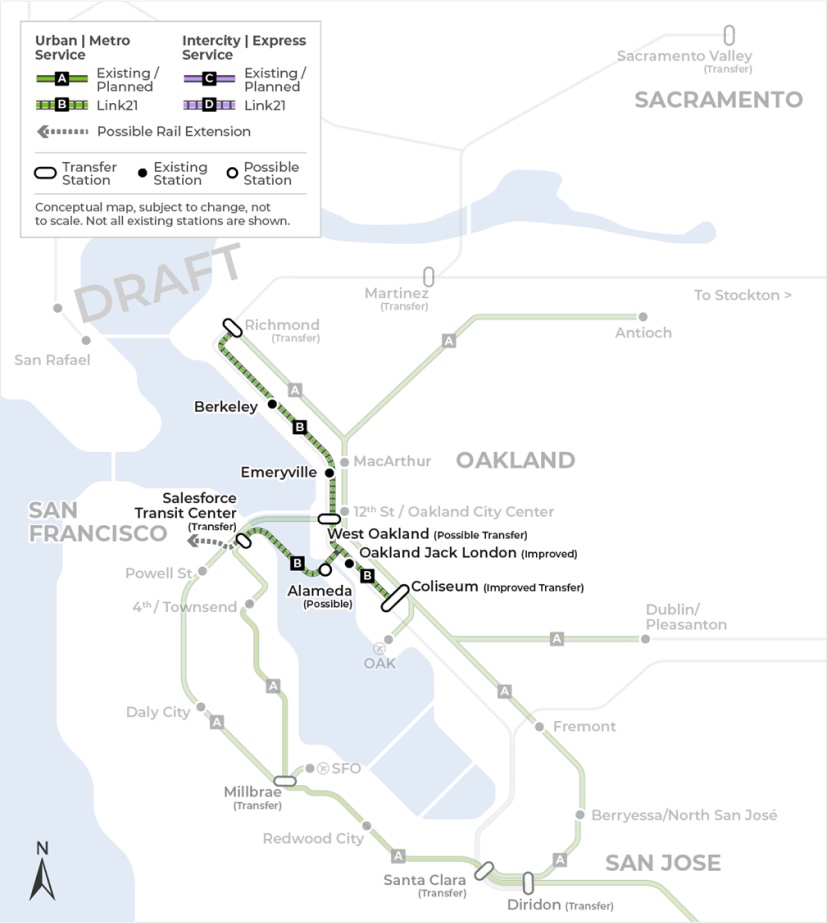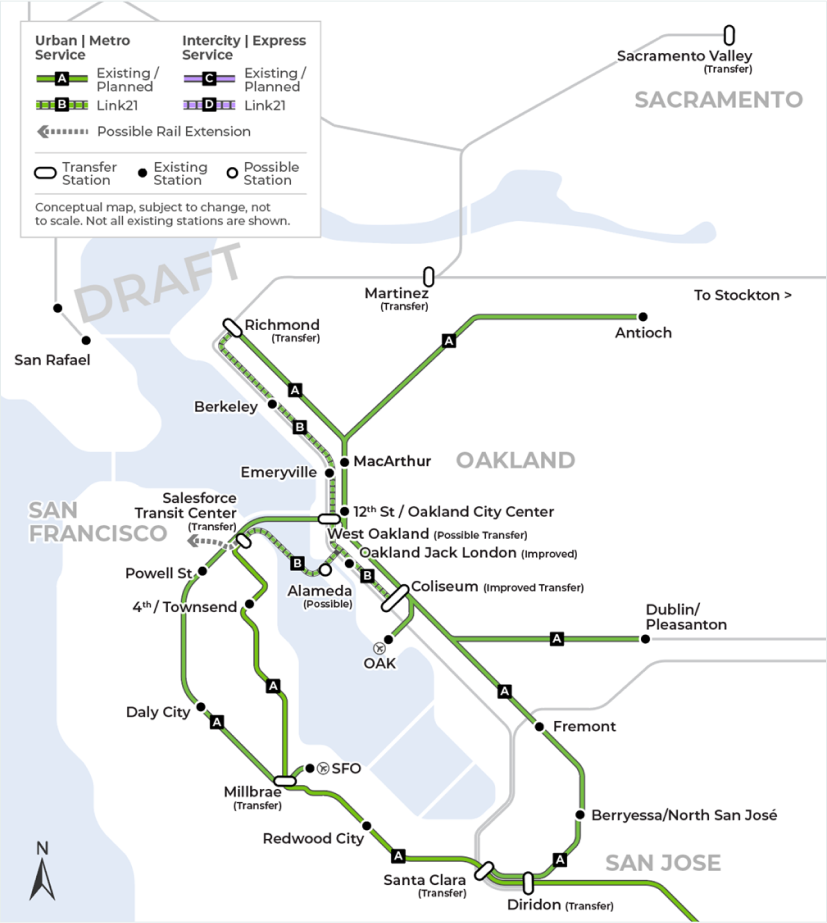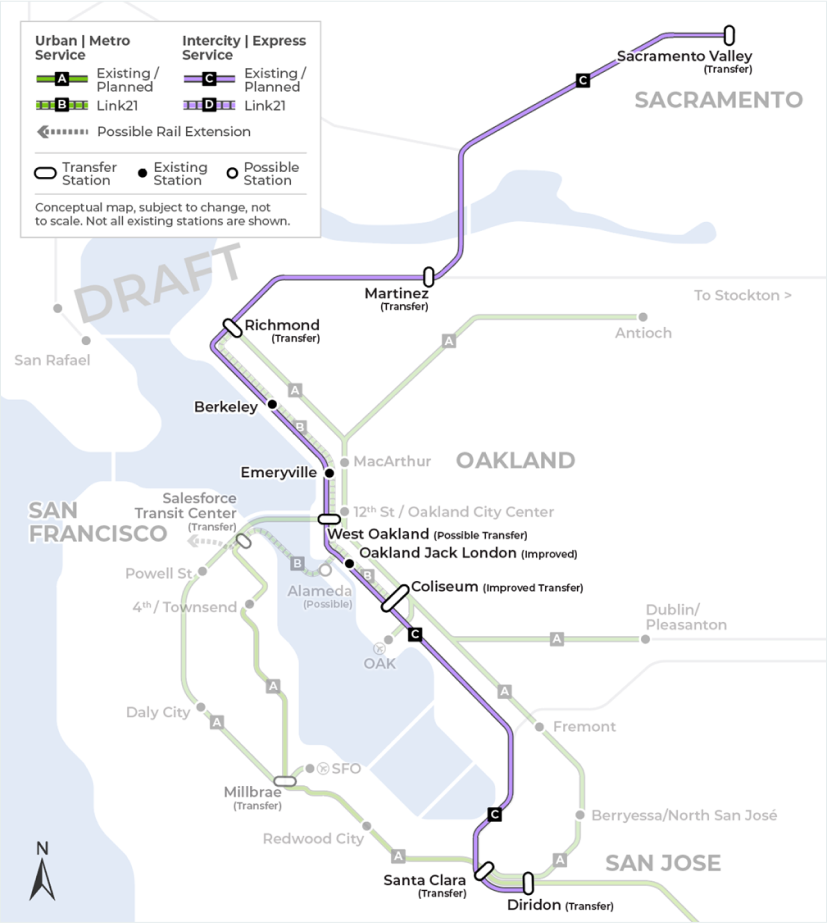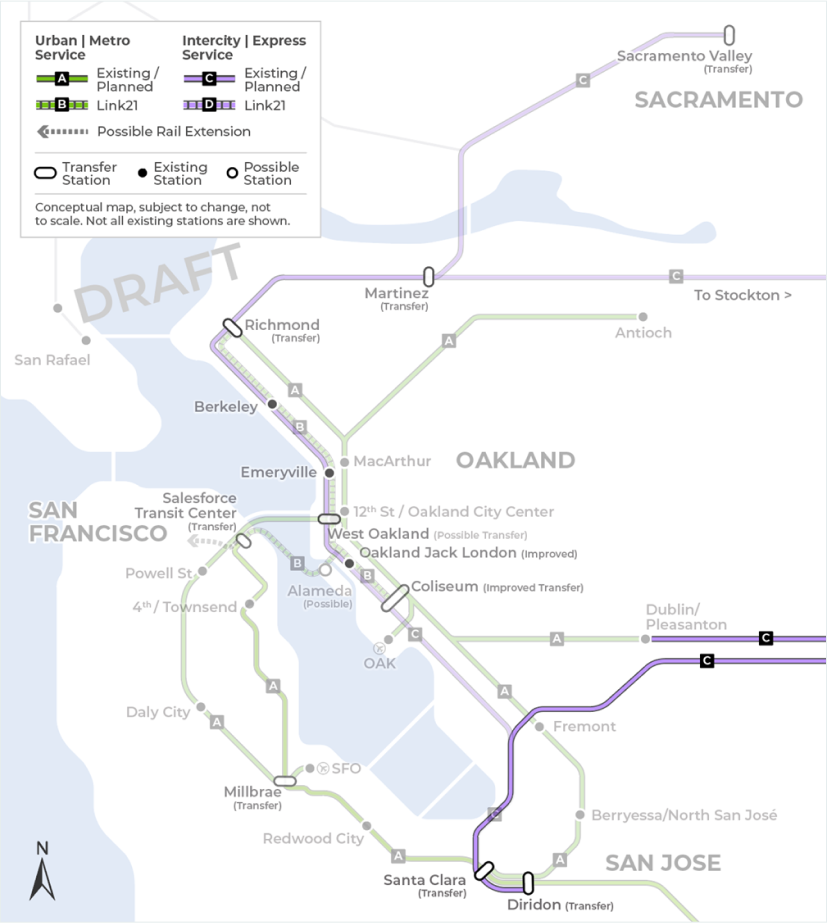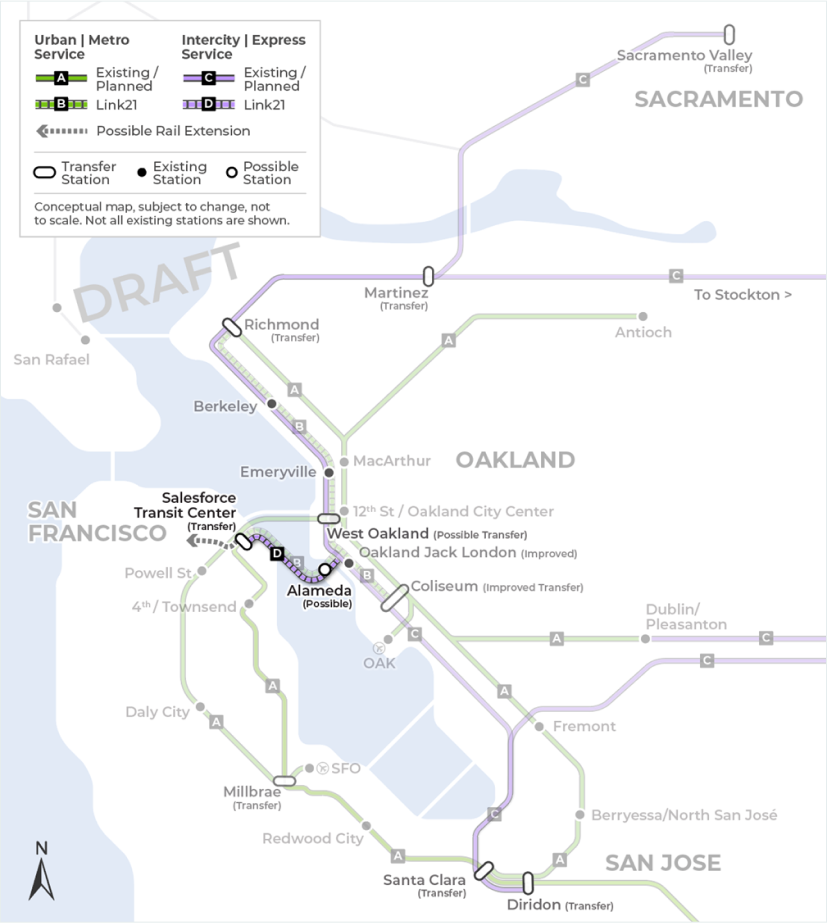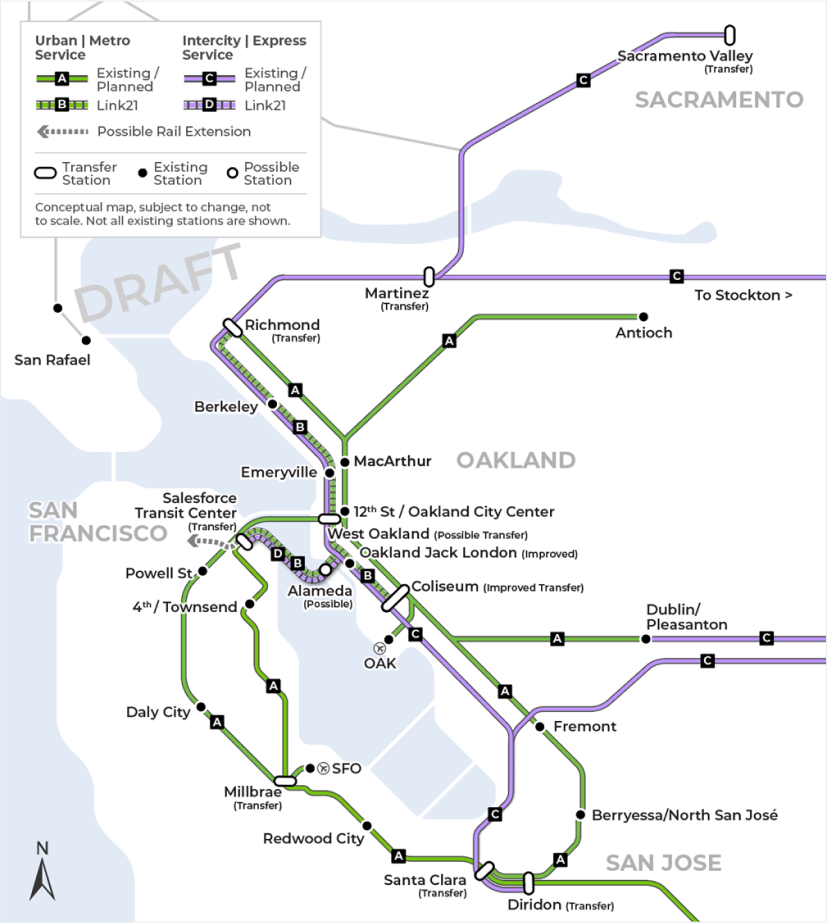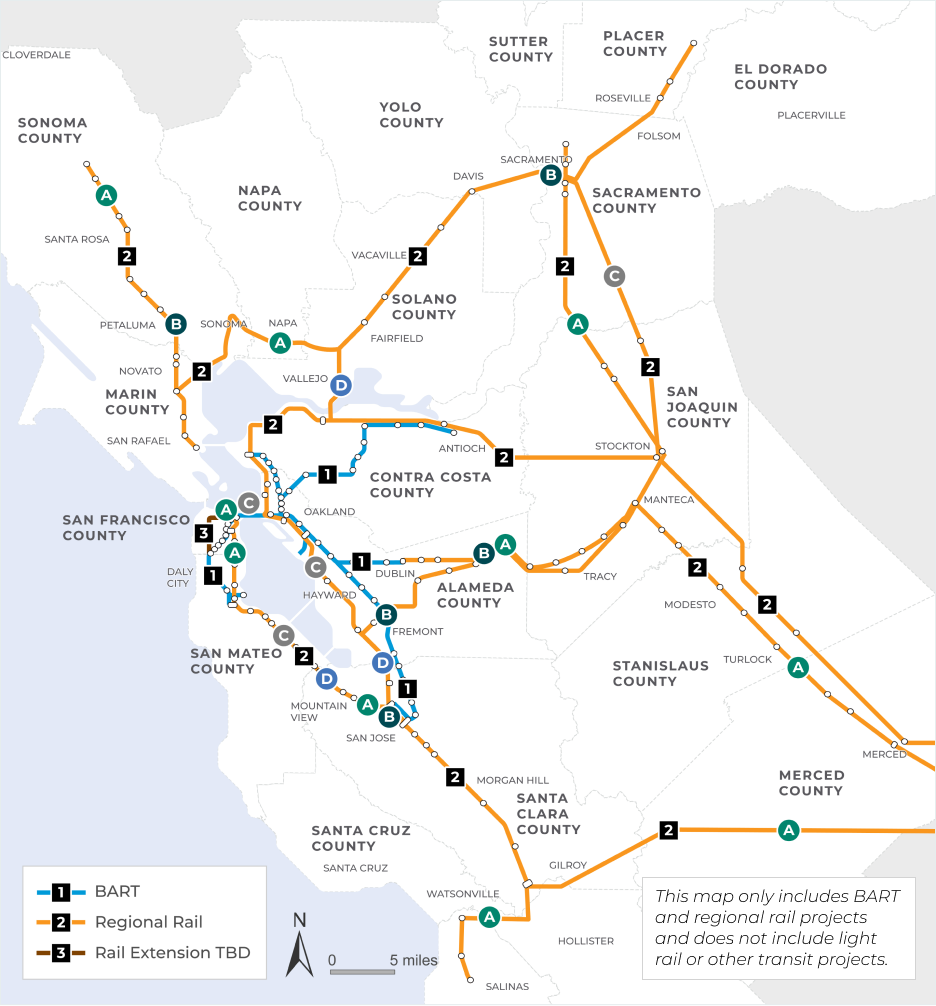What is Link21?
Link21 is a passenger rail Program that aims to improve train travel and connect the rail networks in Northern California. The centerpiece of the Program is a second train crossing between San Francisco and Oakland as envisioned in the California State Rail Plan. Along with the new crossing to accommodate travel within the congested Transbay corridor, Link21 includes improvements to both San Francisco Bay Area Rapid Transit District (BART) and Regional Rail networks.
Link21 Vision
To transform the BART and Regional Rail network into a faster, more connected, equitable, affordable, and accessible train system for future generations of the 21-county Megaregion.
Planning the Future While Finding Solutions for Today
Alongside partner agencies in the Megaregion, Link21 is a Program that is reimagining a better future. While we plan for the future, we are working to find solutions for today’s challenges by considering lessons from the past, understanding current conditions and flexing to accommodate an uncertain future. Link21 is working to understand travel needs, better connect affordable housing to desired destinations, and find transportation solutions that preserve our quality of life.
Economy, Jobs & Housing
Living in the fifth largest megaregional economy in the country, residents experience a high cost of living that has resulted in many of them moving further away from jobs and school in search of affordable housing. As our population and traffic congestion continue to grow we must provide travel options to move conveniently around the Megaregion.
Roadway Congestion & Climate Risks
The imbalance of jobs to affordable housing has resulted in the need to travel longer distances to access destinations which leads to persistent traffic and travel delays on local roads and freeways. Many freeways are back to pre-pandemic congestion levels which causes hours of travel delays and unpredictable travel times. Transportation is a major contributor of pollution and climate-change and we must look for cleaner travel solutions to meet air quality goals for the region and protect the health of future generations.
Passenger Rail Service & Infrastructure
While our passenger rail system is extensive, it is disconnected and has limited routes and service which can make traveling by train inconvenient or not an option at all. Also, having only one Transbay rail crossing (BART tube) between San Francisco and Oakland — one of the most traveled corridors — limits service reliability and redundancy for riders when the tube is shut down for daily maintenance. Better connecting the train network and communities it serves will build ridership, shifting more travel from cars to trains which will provide benefits to all types of travelers.
 Eastbound Interstate 80 entering Bay Bridge from Oakland/Emeryville to San Francisco
Eastbound Interstate 80 entering Bay Bridge from Oakland/Emeryville to San Francisco
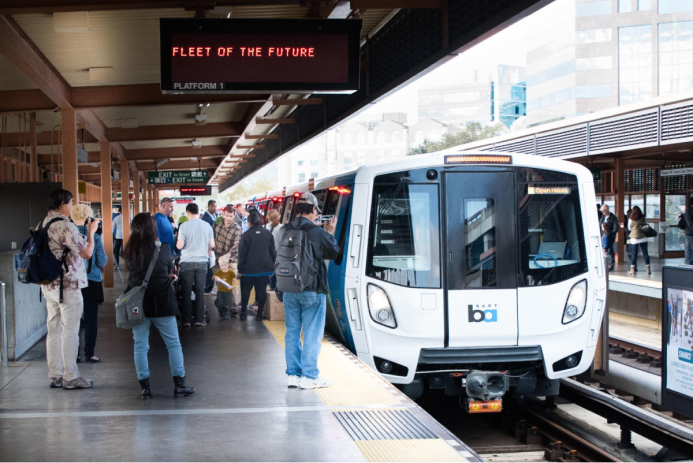 New BART train at Pleasant Hill station
New BART train at Pleasant Hill station
Link21 Program Goals
Early community and stakeholder engagement helped to shape the Link21 goals that seek to enhance livability, community stability, economic opportunity, and environmental quality. These goals are backed by key objectives to support identification, development, and evaluation of rail solutions that will provide benefits across the Megaregion.
Goals & Objectives
Click or tap the items below to learn more.
- Provide better service
- Improve reliability and system performance
- Build ridership and mode share
- Connect people and places
- Improve safety, health, and air quality
- Advance equity and community stability
- Improve access to opportunity and employment
- Connect major economic, research, and education centers
- Enable transit-supportive and equitable land use
- Increase climate change resilience
- Reduce greenhouse gas emissions
- Conserve resources
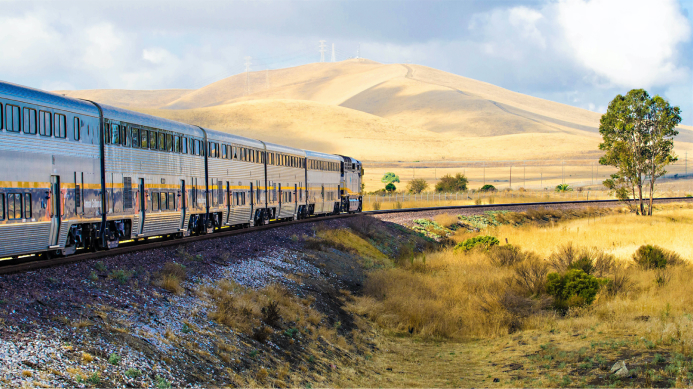 Link21 will create better connections between Northern California intercity train services and BART
Link21 will create better connections between Northern California intercity train services and BART
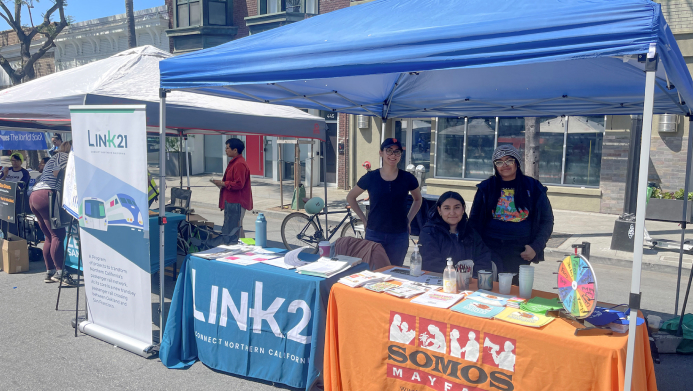 Link21 at San Jose Viva Calle event with SOMOS Mayfair
Link21 at San Jose Viva Calle event with SOMOS Mayfair
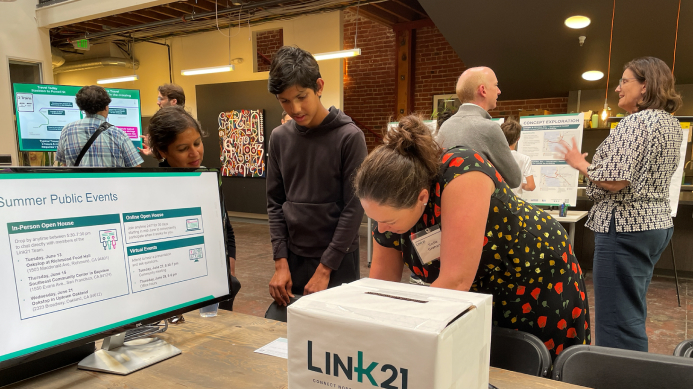 Link21 Program Director interacting with community members at Oakland Link21 Open House
Link21 Program Director interacting with community members at Oakland Link21 Open House
Commitment to Equity
Link21 is prioritizing engagement with communities that have been systematically marginalized to find benefits for those who need it most like the transit dependent, those harmed by past transportation projects or have limited access to important resources like housing and jobs. We are partnering to promote healthy and stable communities while protecting against community instability and displacement.
Equity Embedded in Link21
To advance equity in the Megaregion through accessible and connected passenger rail service so that all people, regardless of their background, have the same opportunity to live happy and healthy lives.
Integrated into Planning and Analysis
- Equity Vision Statement and Blueprint
- Goals, Objectives, and Metrics
- Defining Priority Populations
Equitable Engagement
- Direct and accessible outreach
Community-Based Partnerships & Co-Creation
- Prioritizing communities that have been marginalized
- Partnering to understand needs and identify opportunities
Equity Advisory Council (EAC)
- 18 community representatives from the Northern California Megaregion
- Regular meetings to review information and advise Program
Priority Populations
Link21’s priority populations are geographic areas most impacted by negative economic, mobility, community, health, and safety outcomes. By identifying communities currently experiencing inequitable outcomes, the Program is able to partner with those populations to better understand their needs and design a program that addresses them.
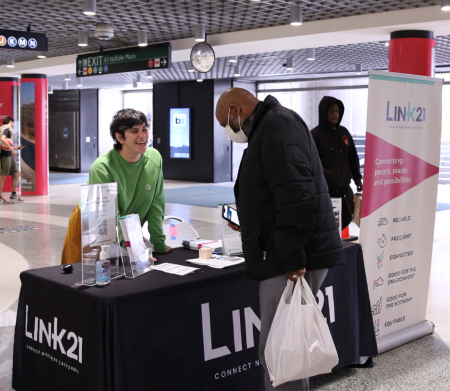 Link21 at Powell Street BART station in downtown San Francisco
Link21 at Powell Street BART station in downtown San Francisco
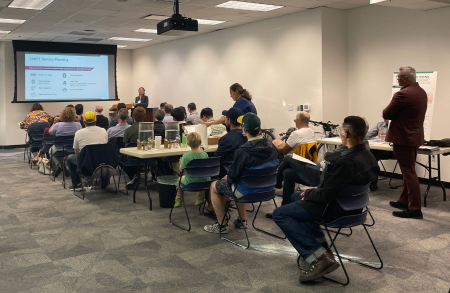 Community Open House at Oakland Jack London Square Business Improvement District
Community Open House at Oakland Jack London Square Business Improvement District
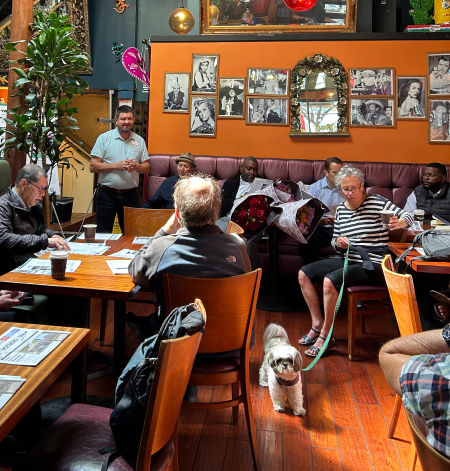 Link21 presentation to Potrero Dogpatch Merchants Association at Papito restaurant in San Francisco
Link21 presentation to Potrero Dogpatch Merchants Association at Papito restaurant in San Francisco
Engagement Highlights
Link21’s robust outreach and engagement program continues to reach targeted communities and residents across the Northern California Megaregion through ongoing communication and unique activities. Since January 2023, we have connected with over 6,300 people at 140 events.
Events, Presentations & Briefings
-
 14
Equity Advisory Council Meetings & Office Hours
14
Equity Advisory Council Meetings & Office Hours
-
 63
Government/Agency Events
63
Government/Agency Events
-
 63
General Public & Targeted Community Events
(In-Person, Virtual & Online)
63
General Public & Targeted Community Events
(In-Person, Virtual & Online)
Communications
-
 21
Electronic Stakeholder Updates & Email Notifications
21
Electronic Stakeholder Updates & Email Notifications
-
 20
Social Media Posts
20
Social Media Posts
-
 7,719
Link21 Subscribers
7,719
Link21 Subscribers
-
 119
Comments Received this Year
119
Comments Received this Year
-
 1,563
Summer Online Open House Participants
1,563
Summer Online Open House Participants
What We’ve Heard — Key Themes
Input focused on service improvements and desire for integrated train network
Access, Connections, and Community
- Ability to easily access stations by bike, walking, or other transit
- Minimize transfers and provide better megaregional connections
- New community connections and desire to minimize potential impacts
Service Improvements
- Faster, increased service frequency, hours of operation, and weekend service
- Better integration between rail operators (service, transfers, fares)
Key Concerns Expressed
- Need for improved safety and security
- Potential community impacts, gentrification or displacement
- Avoiding community resources like churches or other treasured destinations
 Link21 at Cesar Chavez Festival in Mission District of San Francisco
Link21 at Cesar Chavez Festival in Mission District of San Francisco
 Link21 Team engaging with community members at San Francisco Link21 Open House
Link21 Team engaging with community members at San Francisco Link21 Open House
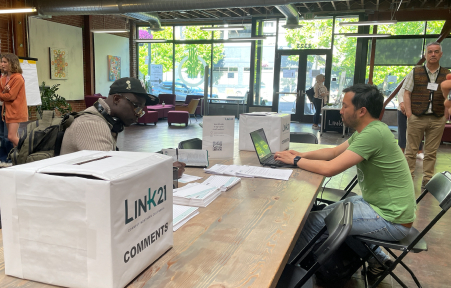 Community members submitting comments at Oakland Link21 Open House
Community members submitting comments at Oakland Link21 Open House
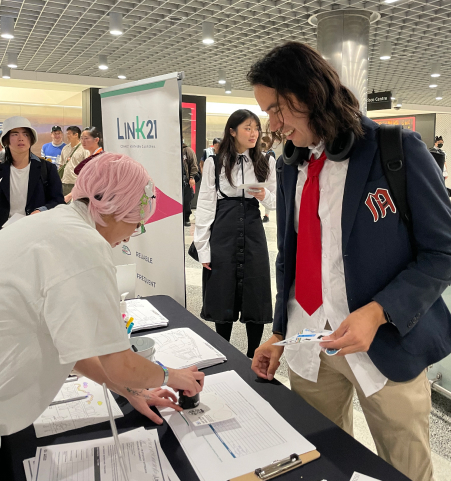 Community members collecting Link21 stamps at Transit Month event to meet BART’s anime mascots at Powell Street BART Station
Community members collecting Link21 stamps at Transit Month event to meet BART’s anime mascots at Powell Street BART Station
Moving Toward a Decision
The Link21 Program is a multi-phase, long-range planning process that includes close coordination with megaregional agency partners, community stakeholders, and the public throughout each phase of work. Since mid-2022, we have been in the Project Identification phase, which is an early planning phase to develop and refine concepts in order to identify a proposed Project that will be evaluated in Phase 2.
Click or tap on the Phases to learn more.
Program Definition Focus
The Program Definition phase included foundational work that established Link21’s Business Case framework defining the Program’s Vision, Goals, and Objectives, and set a decision-making process for evaluating concepts that will ultimately identify future projects. Phase 0 focused on early data gathering, technical work, and stakeholder and public input that included establishing an equity commitment and partnership program with community-based organizations to co-create future rail solutions.
Project Identification Focus
Key Activities
- Identifying potential service improvements
- Assessing benefits of different train technologies to achieve desired service
- Collecting early environmental data and public input that guides exploration, evaluation, and refinement to identify a proposed Project with options
Next Steps
- We have identified early preliminary differentiators and trade-offs with BART or Regional Rail in the crossing. We want to hear from you to understand what’s most important to you. Your input will help to identify a train technology recommendation for action by the BART and Capitol Corridor Boards of Directors next year.
- Following approval to advance by the BART and Capitol Corridor Boards of Directors, work will continue with the public to define a proposed Project with options, ready for Environmental Review in the Project Selection phase.
Project Selection Focus
The Project Selection phase will advance the Program towards the selection of a Project for delivery through ongoing analysis and public input as part of the Environmental Review process. Link21’s proposed Project, and any identified Project alternatives, are required by federal and state laws to have a full detailed environmental analysis performed to identify potential impacts and mitigations to minimize harms to environmental resources as a result of the future Project. These environmental processes are known as the National Environmental Policy Act (NEPA) and the California Environmental Quality Act (CEQA).
Phase 2 will also establish an approved Project and associated implementation strategy for delivery.
Project Delivery Focus
The Project Delivery phase will first focus on the final design of the approved Project, and associated funding strategy. Once the final design is completed and approved, a multi-year construction stage will begin followed by testing of the system and ultimately opening of service.
Important Milestone Coming Soon
In early to mid-2024, we will provide the BART and Capitol Corridor Boards of Directors with a recommendation of whether the new crossing should have BART-gauge tracks or Regional Rail (standard-gauge) tracks. We will also share potential improvements to be further analyzed as part of the next steps in our work.
BART operates as a closed system on broad-gauge tracks that can only be accessed by BART trains. Regional Rail operates on standard-gauge tracks that are used by all trains running on the national railroad network. Each offers benefits and trade-offs, but have implications for the type of service and trips a future Link21 Project could enable for riders.
Choosing the train technology for the new crossing affects the Link21 passenger experience, and how we will connect to and improve service within the larger train network. This is an important first step to further define concepts that will ultimately lead to identification of a future proposed Project.
Example Map of BART in the Crossing
BART-gauge tracks in the new crossing will provide more service within the existing BART network.
Service Improvement Planning | BART in the Crossing
A new crossing provides service redundancy and reliability by allowing trains to operate across the Bay should one crossing temporarily be taken out of service. A new crossing makes the existing train network function better in Northern California while also offering new or improved service to riders. Service enhancements include reduced travel time and increased frequency, with faster transfer opportunities for riders in the Megaregion.
Urban | Metro Service
A type of service that operates within metro regions at higher frequencies and medium average speeds. BART provides this service today. Caltrain will provide this type of service with its modern electrified trains starting in 2024.
- More frequent trains (every 2-10 minutes)
- More stops/shorter distances between stations (1-5 miles apart)
- Medium average speeds
Intercity | Express Service
With a second BART crossing, intercity / express trains (shown in purple) will not cross the Bay. Intercity / Express riders would use existing transfer locations or a new one in Central Oakland to cross the Bay to the San Francisco Peninsula.
Example Train Trips
Travel today versus travel with Link21
Service Improvement Planning | Regional Rail in the Crossing
A new Regional Rail crossing will also provide necessary service redundancy and reliability. With modern Regional Rail trains that are zero-emission, future riders will have access to both Urban | Metro and Intercity | Express services providing more travel options with reduced travel time and increased frequency.
Urban | Metro Service
A type of service that operates within metro regions at higher frequencies and medium average speeds. BART provides this service today. Caltrain will provide this type of service with its modern electrified trains starting in 2024.
- More frequent trains (every 2-10 minutes)
- More stops/shorter distances between stations (1-5 miles apart)
- Medium average speeds
Intercity | Express Service
A type of service for medium to long trips that connects regions, as well as urban and rural communities, at lower frequencies and higher average speeds. Operators like Capitol Corridor, Amtrak, San Joaquins, Altamont Corridor Express, and others provide this service on shared tracks owned by private freight rail.
- Less frequent trains (every 30 minutes–1 hour+)
- Fewer stops/longer distances between stations (5+ miles apart)
- Higher average speeds, faster travel times
Example Train Trips
Travel today versus travel with Link21
What We’ve Learned
BART and Regional Rail networks can work better together with Link21. From our early analysis of concepts, we have learned a number of things. Below are several benefits Link21 provides regardless of whether BART or Regional Rail trains operate in the new train crossing between Oakland and San Francisco.
Either BART or Regional Rail in the Crossing Would:
- Meet travel demand between San Francisco and Oakland by 2050
- Create uninterrupted transbay rail service if one crossing goes out of service
- Improve service reliability and transbay redundancy with two crossings
- Enable increased train frequency that can grow ridership — must be balanced with operating costs and larger fleet
- Provide benefits to priority populations across the network in different ways
- Reduce potential future crowding in existing BART crossing and traffic on Bay Bridge
- Improve or add new centrally-located transfer locations between BART and Regional Rail to save travel time
- Offer additional Urban | Metro service (like BART today — frequent, fast, and timely)
- Extend hours on BART (Requires policy decision/action by BART Board)
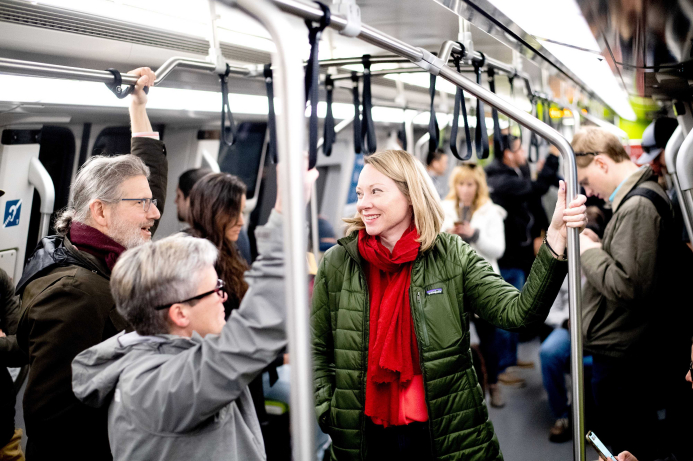 Riders traveling on BART train
Riders traveling on BART train
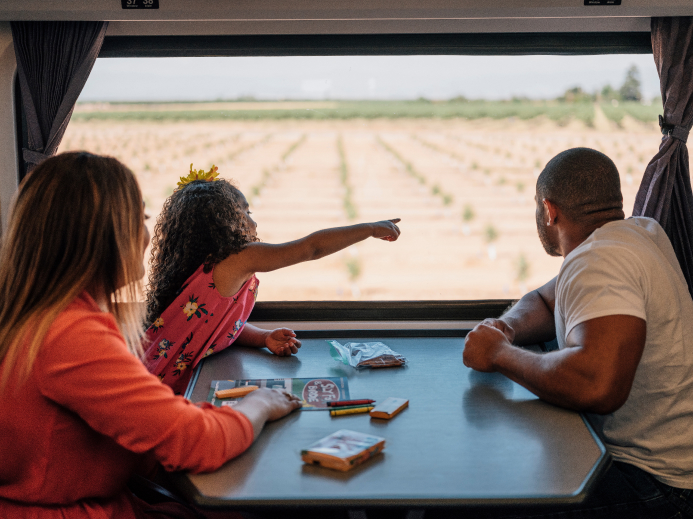 Riders traveling on Amtrak San Joaquins train
Riders traveling on Amtrak San Joaquins train
Rail Improvements in the Megaregion
Throughout the Megaregion, there are currently many plans for rail improvements. A new transbay crossing is essential for improving Northern California rail travel.
Connects Rail Networks
Link21 would strengthen the megaregional rail network by connecting planned rail projects like the Portal (downtown rail extension to Salesforce Transit Center) in San Francisco and Caltrain electrified service on the Peninsula to the existing network in Oakland/East Bay.
Shares Benefits with Future Projects
Link21 can provide more service to and from megaregional destinations with future projects such as the Western San Francisco extension, replacement of the rail lift bridge across the Carquinez Strait, and others.
A Rail Extensions
- North Santa Rosa to Windsor
- Marin to Solano
- Stockton to Sacramento & Merced
- Lathrop to Dublin/Pleasanton
- The Portal (downtown rail extension to Salesforce Transit Center)
- To Western San Francisco (Geary to 19th Ave.)
- To San Jose & Santa Clara
- Monterey/Salinas to Gilroy
- Pajaro to Santa Cruz
- Dedicated tracks: Merced to Gilroy
B New Markets & Enhanced Stations
- North Petaluma
- New stations connecting Tri-Valley to Central Valley
- Irvington Station
- Enhanced Sacramento Valley Station, San Jose Diridon Station
C Service Improvements
- Higher frequency — BART Tube
- Two more round-trip trains — Central Valley for San Joaquins
- More direct route — Oakland to Fremont & higher frequency Sacramento to Roseville for Capitol Corridor
- Electrified fleet, higher frequency, faster service for Caltrain
D Track Improvements (Infrastructure): Studies
- Benicia-Martinez Rail Bridge replacement for Capitol Corridor
- Alviso double-tracking for Capitol Corridor
- Planning some grade-separated tracks, signaling, and automated train control in South Bay for High-Speed Rail
Preliminary Differences & Trade-Offs
BART and Regional Rail technologies each offer distinct services and serve different markets. This means there are many factors that differentiate each choice from the other, and the benefits of each option are different. Weighing these differing benefits is an essential part of the decision Link21 is working toward now.
 Transform the Passenger Experience
By Expanding & Improving Travel Options
Transform the Passenger Experience
By Expanding & Improving Travel Options
BART in the Crossing Benefits
-
 Increases frequency of East Bay BART lines
Increases frequency of East Bay BART lines
-
 Improves reliability with alternative route to existing Transbay Tube
Improves reliability with alternative route to existing Transbay Tube
-
 New transfers to Regional Rail in San Francisco’s Mission Bay and in central Oakland
New transfers to Regional Rail in San Francisco’s Mission Bay and in central Oakland
Regional Rail in the Crossing Benefits
-
 More direct service (one-seat rides)/travel time savings for megaregional trips to San Francisco and the Peninsula
More direct service (one-seat rides)/travel time savings for megaregional trips to San Francisco and the Peninsula
-
 Travel time savings for inner-East Bay / Transbay trips (between Richmond and Salesforce Transit Center)
Travel time savings for inner-East Bay / Transbay trips (between Richmond and Salesforce Transit Center)
-
 Improves Regional Rail reliability with separation of freight from passenger trains in central Oakland
Improves Regional Rail reliability with separation of freight from passenger trains in central Oakland
-
 New transfer to BART in central Oakland
New transfer to BART in central Oakland
 Transform the Passenger Experience
By Connecting Systems and Leveraging Investments
Transform the Passenger Experience
By Connecting Systems and Leveraging Investments
BART in the Crossing Benefits
-
 Leverages existing, planned and potential future BART improvements and connections (example: Silicon Valley BART Extension and Valley Link)
Leverages existing, planned and potential future BART improvements and connections (example: Silicon Valley BART Extension and Valley Link)
Regional Rail in the Crossing Benefits
-
 Allows inter-operability of multiple train services on the megaregional rail network via the new crossing
Allows inter-operability of multiple train services on the megaregional rail network via the new crossing
-
 Leverages existing, planned and potential future regional rail improvements and connections (example: Caltrain electrification, Sacramento Valley Station, Portal, High-speed Rail, and Capitol Corridor Vision Plan)
Leverages existing, planned and potential future regional rail improvements and connections (example: Caltrain electrification, Sacramento Valley Station, Portal, High-speed Rail, and Capitol Corridor Vision Plan)
 Promote Equity and Livability
By Providing Travel Benefits to Priority Populations
Promote Equity and Livability
By Providing Travel Benefits to Priority Populations
BART in the Crossing Benefits
-
 Service benefits throughout BART network, providing benefits to Priority Populations within BART’s service area
Service benefits throughout BART network, providing benefits to Priority Populations within BART’s service area
Regional Rail in the Crossing Benefits
-
 Provides service benefits to large concentrations of Priority Populations located along existing and planned regional rail corridors
Provides service benefits to large concentrations of Priority Populations located along existing and planned regional rail corridors
Regional Rail in the Crossing Considerations
-
 Improvements to at-grade tracks near Priority Populations may require additional mitigation to reduce community impacts
Improvements to at-grade tracks near Priority Populations may require additional mitigation to reduce community impacts
 Support Economic Opportunity and Global Competitiveness
By Enhancing Access to Housing and Jobs
Support Economic Opportunity and Global Competitiveness
By Enhancing Access to Housing and Jobs
BART in the Crossing Benefits
-
 Improved access to jobs with increased frequency of BART service
Improved access to jobs with increased frequency of BART service
-
 Potential connectivity to jobs and housing at Mission Bay and SOMA in San Francisco
Potential connectivity to jobs and housing at Mission Bay and SOMA in San Francisco
Regional Rail in the Crossing Benefits
-
 Improved megaregional access to jobs/housing in SF and the Peninsula
Improved megaregional access to jobs/housing in SF and the Peninsula
-
 Expands connectivity between job centers and less expensive housing
Expands connectivity between job centers and less expensive housing
 Deliverability and Financial Considerations
Opportunities and Challenges for Implementation
Deliverability and Financial Considerations
Opportunities and Challenges for Implementation
BART in the Crossing Benefits
-
 More established federal funding process
More established federal funding process
-
 Likely does not require new governance
Likely does not require new governance
BART in the Crossing Considerations
-
 Limited Federal Transit Administration funding may require other funding sources
Limited Federal Transit Administration funding may require other funding sources
-
 Might compete with other BART funding needs
Might compete with other BART funding needs
Regional Rail in the Crossing Benefits
-
 Leverages more funding and financing options (Federal Railroad Administration funding)
Leverages more funding and financing options (Federal Railroad Administration funding)
-
 Is an important component within California State Rail Plan
Is an important component within California State Rail Plan
Regional Rail in the Crossing Considerations
-
 More investment needed than BART in crossing (Regional Rail has not had high levels of investment)
More investment needed than BART in crossing (Regional Rail has not had high levels of investment)
-
 May require increased interagency involvement and new governance
May require increased interagency involvement and new governance
-
 Requires host railroad engagement on changes proposed within their right of way
Requires host railroad engagement on changes proposed within their right of way
Take Our Survey
We want to hear what is most important to you! Thank you for participating in this short, anonymous survey to help us connect Northern California with better train service for future generations.
What Happens Next?
Looking ahead, our partnerships with megaregional agencies and community stakeholders are critically important as we work to identify and further define a proposed Link21 Project over the next two years. We will be proactively reaching out to share information and collaborate on solutions that best meet your needs — stay engaged with us!
Ongoing Activities
Targeted & Megaregional Collaboration
- Jurisdictions and agency partners (elected officials, management, staff)
- Transit and community advocacy
- Equity Advisory Council
Planning
- Ridership modeling
- Cost estimating
- Service planning
- Concept assessment and refinement
- Link21 recommendation identification
Program Milestones
Fall 2023: Targeted & Megaregional Outreach
- Provide Program update
- Share preliminary differentiators and trade-offs
- Gather input
Early 2024: Targeted & Megaregional Outreach
- Share evaluation results and recommendation
- Gather input
Spring 2024: BART & Capitol Corridor Boards of Directors
- Preliminary Project recommendation (concept with options — crossing technology decision)
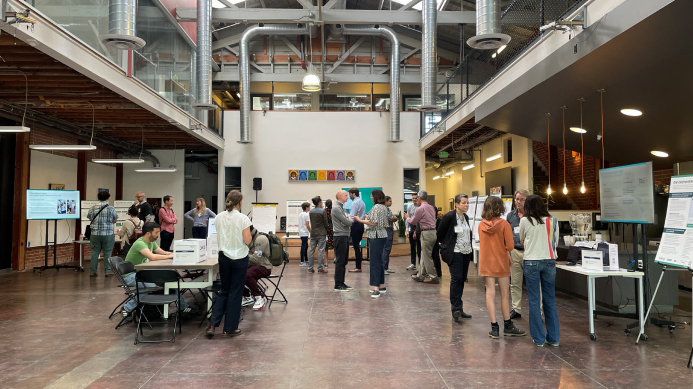 Link21 Team engaging with community members at Oakland Link21 Open House
Link21 Team engaging with community members at Oakland Link21 Open House
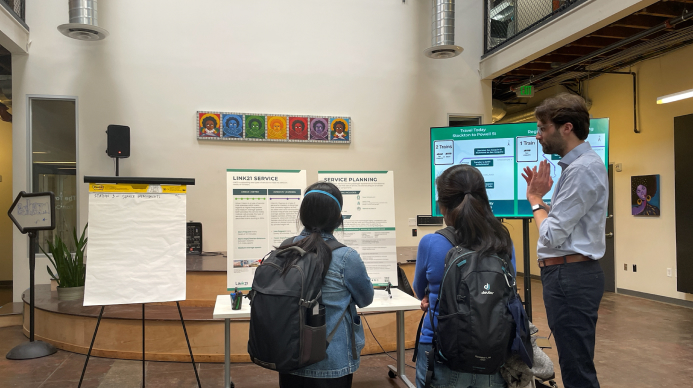 Community members asking Link21 Team questions at Oakland Link21 Open House
Community members asking Link21 Team questions at Oakland Link21 Open House
 Amtrak San Joaquins conductor assisting passenger with loading bicycle onto train
Amtrak San Joaquins conductor assisting passenger with loading bicycle onto train
